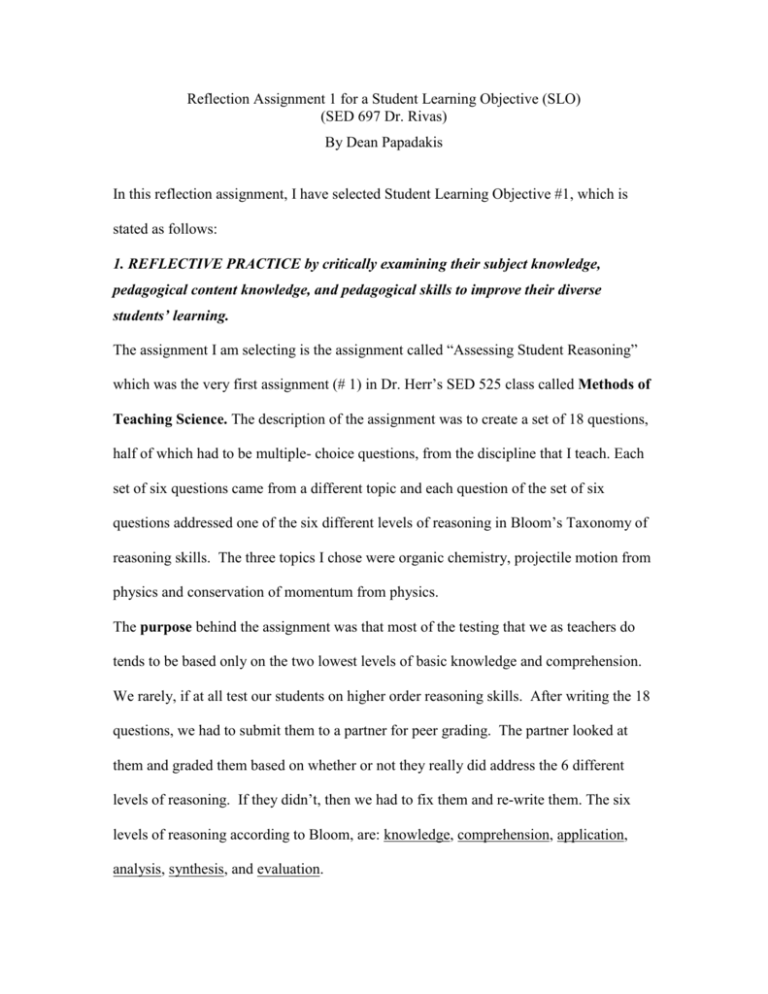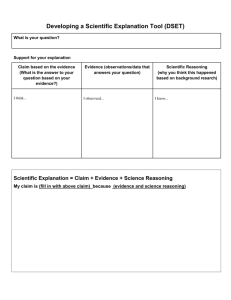Bloom's Taxonomy & Student Reasoning Reflection
advertisement

Reflection Assignment 1 for a Student Learning Objective (SLO) (SED 697 Dr. Rivas) By Dean Papadakis In this reflection assignment, I have selected Student Learning Objective #1, which is stated as follows: 1. REFLECTIVE PRACTICE by critically examining their subject knowledge, pedagogical content knowledge, and pedagogical skills to improve their diverse students’ learning. The assignment I am selecting is the assignment called “Assessing Student Reasoning” which was the very first assignment (# 1) in Dr. Herr’s SED 525 class called Methods of Teaching Science. The description of the assignment was to create a set of 18 questions, half of which had to be multiple- choice questions, from the discipline that I teach. Each set of six questions came from a different topic and each question of the set of six questions addressed one of the six different levels of reasoning in Bloom’s Taxonomy of reasoning skills. The three topics I chose were organic chemistry, projectile motion from physics and conservation of momentum from physics. The purpose behind the assignment was that most of the testing that we as teachers do tends to be based only on the two lowest levels of basic knowledge and comprehension. We rarely, if at all test our students on higher order reasoning skills. After writing the 18 questions, we had to submit them to a partner for peer grading. The partner looked at them and graded them based on whether or not they really did address the 6 different levels of reasoning. If they didn’t, then we had to fix them and re-write them. The six levels of reasoning according to Bloom, are: knowledge, comprehension, application, analysis, synthesis, and evaluation. Here is how this assignment related to Student Learning Objective #1. It first of all required critical examination of the subject matter in the material that my students are supposed to learn. Also, as a teacher, I must acknowledge that no matter where I teach, my students will represent a group of students that have diverse backgrounds and diverse ways in which they learn material. Once I realize this, I will realize that I must critically examine what teaching techniques I am using to teach my students. This assignment required that I have an understanding of the pedagogical content knowledge, which is the content that relates to the way I teach my students. If I want my students to learn the material that they are supposed to learn, I must be able to test my students appropriately, in order to find out if they really are learning the material that I give them. I learned that the questions that I normally give to my students on a test, are really only testing their low-level knowledge and comprehension of the material. The higher order thinking and learning of comprehension, application analysis, synthesis and evaluation, must also be tested. I thought that in order to test students’ higher levels of reasoning requires essay type questions. This is not the case. I learned from this assignment that it is possible to give students multiple-choice questions that test their higher order levels of reasoning. This of course does take some effort to make the questions appropriate and in this assignment, we had the opportunity to make these types of questions. The other part of the assignment was to work with a partner and have the partner evaluate the questions that I created, and even grade the questions, in terms of whether they addressed each of the 6 levels of Bloom’s Taxonomy. I found that some of the questions I created had to be adjusted for the particular category. Some of them were misplaced in a category also. Overall, the assignment was very useful to me and allowed me to see that it is possible to ask multiple-choice questions that can address the higher order levels of reasoning, in the same way that an essay question can.








